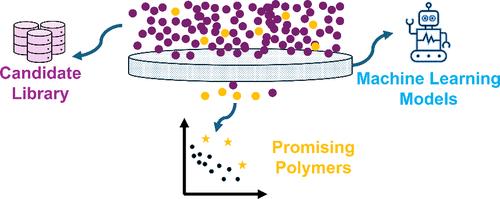创新聚合物的机器学习辅助分子设计
摘要
人工智能(AI)和机器学习(ML)驱动的新范式显著加快了聚合物材料研究的迭代速度。传统的聚合物发现实验方法长期以来依赖于反复试验,需要大量的时间和资源,同时对化学设计空间的访问也有限。相比之下,机器学习辅助策略为有效地导航这一复杂景观提供了一个变革性的框架。本文着重于分子水平上的聚合物设计。通过整合数据驱动的方法,研究人员可以以前所未有的速度提取结构-性质关系,预测聚合物性质,并优化分子结构。机器学习驱动的聚合物设计遵循以下结构化方法:(1)数据库构建;(2)结构表示和特征工程;(3)基于机器学习的性能预测模型开发;(4)潜在候选物的虚拟筛选;(5)通过实验和/或数值模拟进行验证。该工作流面临两个主要挑战。首先是高质量聚合物数据集的可用性有限,特别是对于具有特殊性能的先进材料。二是虚拟聚合物结构的生成。不像小分子药物的发现,存在着大量的候选化合物库,聚合物化学缺乏一个假设结构的等效库。最近的努力利用基于规则的聚合反应和生成模型来创建假设聚合物的大规模数据库,显着扩展了设计空间。此外,聚合物结构的多样性,其性质的广泛范围,以及训练样本的有限可用性增加了开发准确预测模型的复杂性。解决这些挑战需要创新的机器学习技术,如迁移学习、多任务学习和生成模型,以从稀疏数据中提取有意义的见解并提高预测可靠性。这种数据驱动的方法能够发现用于航空航天、电子、能源存储和生物医学工程的新型高性能聚合物。尽管取得了这些进步,但仍存在一些障碍。机器学习模型的可解释性,特别是深度神经网络,是一个紧迫的问题。虽然黑盒模型可以实现显著的预测准确性,但理解它们的决策过程仍然具有挑战性。人们越来越多地探索可解释的人工智能方法,以提供对特征重要性、模型不确定性和潜在化学驱动聚合物性质的见解。此外,必须仔细考虑ml生成的候选物的可合成性和可加工性,以确保实际的实验验证和现实世界的应用。本文综述了机器学习辅助高分子材料分子设计的最新进展,重点介绍了数据库开发、特征表示、预测建模和虚拟聚合物生成等方面的研究进展。我们重点介绍了新兴的方法,包括基于变压器的语言模型、物理信息神经网络和闭环发现框架,它们共同提高了聚合物信息学的效率和准确性。最后,我们讨论了机器学习驱动聚合物研究的未来前景,强调需要数据科学家、化学家和工程师之间的合作努力,以完善预测模型,整合实验验证,并加速下一代聚合物材料的开发。通过利用计算建模和实验见解之间的协同作用,机器学习辅助设计有望彻底改变聚合物的发现,使可持续的高性能材料能够快速发展,为各种应用量身定制。

A new paradigm driven by artificial intelligence (AI) and machine learning (ML) is significantly accelerating the iterative pace of polymer materials research. Traditional experimental approaches to polymer discovery have long relied on trial and error, requiring extensive time and resources while offering limited access to the vast chemical design space. In contrast, ML-assisted strategies provide a transformative framework for efficiently navigating this complex landscape. This paper focuses specifically on polymer design at the molecular level. By integrating data-driven methodologies, researchers can extract structure–property relationships, predict polymer properties, and optimize molecular architectures with unprecedented speed. ML-driven polymer design follows a structured approach: (1) database construction, (2) structural representation and feature engineering, (3) development of ML-based property prediction models, (4) virtual screening of potential candidates, and (5) validation through experiments and/or numerical simulations. This workflow faces two central challenges. First is the limited availability of high-quality polymer datasets, particularly for advanced materials with specialized properties. Second is the generation of virtual polymer structures. Unlike small-molecule drug discovery, where vast libraries of candidate compounds exist, polymer chemistry lacks an equivalent repository of hypothetical structures. Recent efforts have leveraged rule-based polymerization reactions and generative models to create large-scale databases of hypothetical polymers, significantly expanding the design space. Additionally, the diversity of polymer structures, the broad range of their properties, and the limited availability of training samples add complexity to developing accurate predictive models. Addressing these challenges requires innovative ML techniques, such as transfer learning, multitask learning, and generative models, to extract meaningful insights from sparse data and improve prediction reliability. This data-driven approach has enabled the discovery of novel, high-performance polymers for applications in aerospace, electronics, energy storage, and biomedical engineering. Despite these advancements, several hurdles remain. The interpretability of ML models, particularly deep neural networks, is a pressing concern. While black-box models can achieve remarkable predictive accuracy, understanding their decision-making processes remains challenging. Explainable AI methods are increasingly being explored to provide insights into feature importance, model uncertainty, and the underlying chemistry driving polymer properties. Additionally, the synthesizability and processability of ML-generated candidates must be carefully considered to ensure practical experimental validation and real-world application. In this paper, we review recent progress in ML-assisted molecular design of polymer materials, focusing on database development, feature representation, predictive modeling, and virtual polymer generation. We highlight emerging methodologies, including transformer-based language models, physics-informed neural networks, and closed-loop discovery frameworks, which collectively enhance the efficiency and accuracy of polymer informatics. Finally, we discuss the future outlook of ML-driven polymer research, emphasizing the need for collaborative efforts between data scientists, chemists, and engineers to refine predictive models, integrate experimental validation, and accelerate the development of next-generation polymeric materials. By leveraging the synergy between computational modeling and experimental insights, ML-assisted design is poised to revolutionize polymer discovery, enabling the rapid development of sustainable, high-performance materials tailored for diverse applications.

 求助内容:
求助内容: 应助结果提醒方式:
应助结果提醒方式:


